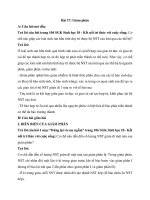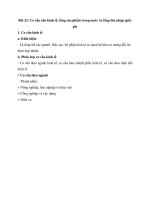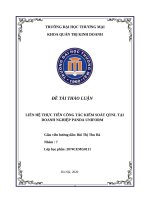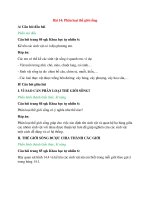18 hypertrophy training exercise selection and order part i 2
Bạn đang xem bản rút gọn của tài liệu. Xem và tải ngay bản đầy đủ của tài liệu tại đây (629.26 KB, 10 trang )
UNIVERSITY
Hypertrophy
Training
Exercise Selection, Order
and Execution Part I
The Lesson
PART I
Managing the stimulus to fatigue ratio
Ensuring you train the target muscle
Matching the movement to your abilities
Why bracing, stabilizing, and control are important factors
Matching Strength and Resistance Profiles
PART II
Multi joint vs single joint lifts pros and cons
Lift execution (tempo, mind muscle connection, rest times)
Session and weekly exercise order planning
Exercise variation planning
Stimulus to Fatigue Ratio
For hypertrophy the exercise is just the means to deliver tension in the
intended muscle. Many exercises can get the job done.
We want to maximize the stimulus and reduce the amount of systemic
fatigue it creates.
Low stimulus and high fatigue lifts will produce little result but make
recovery very challenging. EX: ¼ rep squat, Rack pull
High stimulus and low fatigue lifts will create a lot of stimulus and not
effect recovery as much, so you can train more and harder. Ex: leg
extension for quads, bicep curl. *issue is not very efficient with time
High stimulus and high fatigue lifts are needed for efficiency
standpoint. EX: full ROM squat, bench press, BB row.
Next points we will cover how to maximize stimulus, recognize a good
stimulating lift and limit fatigue
Does it train the intended muscle?
Ensure movement pattern aligns with joint and muscle function
Line of pull/push is in alignment with target muscle fiber
Joint function is not bound or compromised
Poor lines or pull/push can compromise joints creating excessive
fatigue and poor stimulus
Does it train the intended muscle?
The target muscle should be the limiting muscle in the lift
Joint the muscle works on is farthest from line of resistance force
(knee far from yellow line)
Target muscle joint allows for large ROM
Stimulate the muscle you want, limit stimulus to other muscle groups
Does it train the intended muscle?
You don’t need to be a biomechanics expert though, simple works:
Do you feel tension in the target muscle?
Should feel a tight cramp like contraction while training the muscle
Pump in the muscle
After you do a hard set do you get a good pump in the muscle you
want to target?
Muscle fatigue
Does the muscle feel weak and tired after the set?
Next day is there localized muscle soreness?
If you feel these things you are getting a good stimulus
Does it match with your abilities?
Test your mobility and movement for an exercise under ZERO load, your
exercise selected should pair with this mobility
Do NOT force a range of motion you do not have
Do NOT work in a range you can NOT control
Work within the active ROM of the intended muscle group.
EX: RDL with lower back rounding to when goal is hamstring training
EX: Touching the chest on Incline BB bench when pec is already
lengthened fully
Movement pattern causes pain, switch the lift or change the ROM.
Working outside of your abilities will cause excessive fatigue and risk of
injury
Remember: stimulate, recover, sustainable. Getting injured is not
sustainable lifting.
Brace, Stabilize, Control
Lifts that allow bracing create more stability for force delivery. Lacking
stability you are creating a lot of fatigue and not stimulus.
• Squatting on ground verse Squatting on a BOSU ball
• Back Squat verse Hack Squat
• Standing OHP verse Seated OHP
Lifts that are braced are more repeatable, which makes for more
accurate tracking of progression.
Braced and stable lifts also allow quicker motor learning, great for
beginners and allow for loading adequate for growth and less learning.
Less braced lifts are acceptable, just ensure the goal of directing a
hypertrophy stimulus were you intend is possible.
How is the profile?
Where in the movement can you produce more force?
• Length tension relationship
• In general muscle produces more force fully lengthened (greatest
hypertrophic potential)
• However duration of that tension matters as well
• Maximal tension throughout ROM
Exercise might ”challenge” the muscle more shortened, mid range, or
lengthened.
BB hip thrust (short) vs DB curl (mid range) vs DB pec fly (lengthened)
Does the resistance the weight or machine provide match where you are
strongest in the movement?
Does the resistance or weight challenge you through out the ROM
Free weight vs pulley-based machines vs variable resistance machines vs
bands/chain additions
We want to match the strength and resistance profiles the best that we can
Summary
PART I
Maximize target muscle stimulus and limit fatigue
Line up force lines of push/pull and proper joint mechanics that target
intended muscle group
Train within your active range of motion and mobility limitations
Find movements that allow control through bracing and stabilization
Matching Strength and Resistance Profiles of movements
Big picture do you feel the muscle contract, get pumped, get fatiguing?









